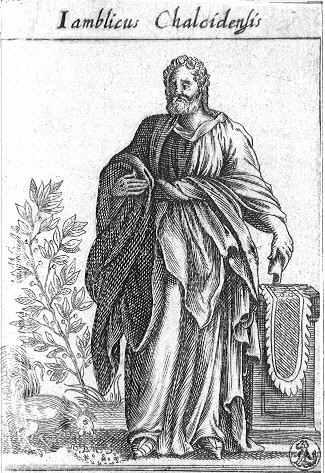
When the Neoplatonists combined Plato and Aristotle in their mystical philosophy, they fully intended to synthesize the best of all the available western philosophies of the day. What they did not know was that one of their own, Iamblichus, would "defect" from their pure theoretical vision and get his hands dirty doing things like justifying (pagan) sacrifice. In a last ditch effort to save dying classical paganism from the new religion, Julian the Apostate used theurgical Neoplatonism in order to justify and promote the pagan sacrificial religion of the crumbling empire.
So much for the history. Theurgy means god-work, or god-action. As opposed to thaumaturgy, which means wonderworking. Thaumaturgy is just straightforward "magic," or sorcery. Theurgy is "magic" for spiritual, transcendent ends, rather than material and immediate ends.
The Neoplatonic myth was that of emanations from the One. The goal of the philosopher was to meditate back to the one and escape the illusion, ugliness, evil, unreality and multiplicity of the emanated world. Iamblichus and the theurgist agreed with this synthetic vision, but used the apophatic theology of Neoplatonism to create a paradox requiring physical ritual and transformation in order to return to that primordial unity. If the One were incomprehensible, inconceivable, etc., then how could a mere human being actually meditate his or her way back to the one? The answer for Iamblichus and the theurgists? You couldn't. But what you can do is use the rituals revealed by divine hierarchs in order to retrace the steps of creation and, as a physical being, in the world of the physical, using physical objects and offering them in sacrifice to the gods, return to that primordial and blessed state.
Through theurgy, the adept imitates (mimesis) the Creator (the demiurge) in a ritual reenactment of the creation of the cosmos. This imitation takes the form of pagan sacrifice and other amalgams of superstition and magical rituals in imitation of the "sacrificial" means of bringing about the material universe on the part of the one through emanation. These sacrifices aren't necessarily the "gross" kind. It could be libations of wine, burning of grain or incense, you name it. But something is usually lost, emptied or consumed (by fire). These ritual actions are means of both personal meditative return, and, eventually, the return of the entire material cosmos, to the One. (If this sounds a bit Hindu at this point, you should not be surprised. Yogic and Tantric Hinduism on the one hand, and pure and theurgical Neoplatonism on the other, are both parallel Indo-European religious systems.)
Well, this is all very interesting stuff. My own Christian commitments make me want to tell this story a bit differently. But what about monome?

Perhaps the main reason why I love the monome interface for making music is that it allows real-time manipulation of sequences, patterns, samples, data. This manipulation of patterns in "real-time," and not just in meditative thought - like an old-school MIDI-sequencer - makes the monome thus a kind of musical theurgical device. Just as the theurgical adept imitates the demiurge in following the patterns of emanation in ritual performance, so too the conductor of the monome creates new patterns and manipulates them in real-time just as the Creator, although creating from pre-existent patterns, nevertheless reacts to and manipulates those patterns "on the fly" as per-necessary. Creation "ex nihilo" is creation out of nothing previously hanging around, not simply out of "nothingness" at all. The patterns pour out of the infinite mind of the Creator.
So conducting the monome is like a ritual performance or mimesis of the divine act of creation itself! That is why the monome is so obvious a musical tool to those who are attracted to it. It causes the (new to be) conductor to exclaim: it is so obvious! Why hasn't it been around longer! (See Antimon's comment on the monome community's discussion thread "So I have this ponderage . . . ")
The monome as theogony: Orpheus was the greatest musician because he sang the birth of the gods. When you see something like Edison's fingers at work, you see someone tapping out the birth of the gods (perhaps I am pushing my fortuna?). The monome, in its minimalist and pattern driven simplicity, allows the artist a kind immediacy to the creative moment - both in him or herself, and, I believe, thereby, to divine creativity that is channeled through our human sub-creativity. (Just look at some of the divine creations made possible by this device, for example, on the Vimeo Monome Group.)
So I am getting increasingly more theological. But I haven't quite gotten there yet. More to come. Thanks for reading!
OK. This is a good one. I need to read it again, but there are some really fecund distinctions, like "real-time" versus meditative thought, in which privledge the former. Hmmmmm.....
ReplyDeleteAh, I am not formerly familiar with Iamblichus, but history and analogy are, of course, favorites. Reminds me I need to get back to Hadot. I too, will need a reread for discussion purposes - read last night, concentration not too on this evening - but quite intriguing. Perhaps I'll roll on down and make some music-related comments...
ReplyDeletewhy? is it because thaumaturgy is essentially evil while theurgy is of the good?
ReplyDeleteAnonymous - Not sure I follow the question. Could you give us a handle or name? Thanks for posting.
ReplyDelete